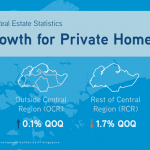Pivotal role of flexible workspace envisaged as increased enterprise demand for them as markets recover from the coronavirus pandemic (COVID-19)
- Models such as Flex and CoreTM, Hub & Spoke and Digital Campus to to lead pivotal role of flexible workspace as they become more common as enterprises look to restructure their occupational portfolios
- Asset owners to work together with operators to deliver holistic offerings to occupiers as pivotal role of flexible workspace is accentuated
- Pivotal role of flexible workspace may be witnessed in an occupier “flight to safety” in addition to a “flight to quality”
- Singapore: Operators expected to play a pivotal role of flexible workspace in the return to work
- Hong Kong: WeWork has handed back several locations, although enterprise demand for flexible workspace should buoy the sector in 2H 2020
- Shanghai: Operator growth is likely to be attributable to partnerships or management agreements with asset owners
- Sydney: Increased flexibility in incentives and terms being offered by flexible workspace operators

Colliers International on July 23, released The Flexible Workspace Outlook Report 2020. This annual report provides an overview of the overarching trends that are shaping the sector, implications for operators, occupiers and asset owners, as well as forecasts the pivotal role of flexible workspace for the industry in 2020.
Jonathan Wright, Director, Flexible Workspace Consulting, Asia, at Colliers commented: “Events in late 2019 and H12020 have accelerated previously forecasted trends in the flexible workspace sector, including enterprise outsourcing becoming mainstream; highly amenitised assets with best-in-class hospitality being ‘table stakes’ for any new office development; a continued boom in wellness offerings; a revival of suburban locations; and further operator fragmentation, while new trends have also emerged, such as the integration of home as a place of work and the growing importance of the digital experience.”
Sam Harvey-Jones, Managing Director, Occupier Services, Asia, added: “As markets start to recover from the effects of COVID-19, we expect to see an increase in demand for flexible workspace models, particularly because there will be a greater emphasis on health and wellbeing, hygiene, and work-life balance in the workplace going forward. Businesses will likely adopt smaller office ‘hubs’ in decentralised locations, allowing them to save on space / costs while also benefiting their employees who will have shorter commute times.”
Flexible Workspace Occupier Models 2020 and he pivotal role of flexible workspace
Managed Office
A fully outsourced workspace that is a customised, private environment delivered and managed by a third party. Occupiers can increase the flexibility of their portfolio through shorter commitments, mitigated capital expenditure and reduced balance sheet liability.
Flex and CoreTM
An occupier partners with an operator to enter an asset. The occupier either commits to less space for their core requirement and the operator/asset owner launches a flexible workspace location in the same building or the occupier commits to ‘anchor’ the new location and provides options for future expansion.
Reverse Flex
An occupier can reduce property costs by partnering with a flexible workspace operator to repurpose space into flexible workspace, thus mitigating property expenses and even generating income.
Hub & Spoke
If an occupier wants to reduce the reliance on a single headquarter building and implement a dispersed occupancy strategy, it can take smaller hubs across a city, region or country (i.e. in lower cost locations), resulting in improved work/life balance for employees and reduced commute times.
Digital Campus
When an occupier has teams or individuals that work remotely or travel frequently, it can offer membership to a network of drop-in spaces across a region, improving efficiency and productivity for its remote workforce while also reducing physical office space and fixed property expense
Outlook for Key Markets in Pivotal Role of Flexible Workspace
Singapore:Flexible workspace operators are expected to play a key role in the return to work for many enterprises in Singapore and the scale of the sector presents an opportunity for operators to offer a range of products to assist occupiers in executing their occupancy strategies. New take-up from flexible workspace operators will mostly pause over 2020, with any new take-up being driven by partnerships or management agreements with asset owners.
Brisbane: Brisbane is expected to shift further towards a tenant favourable market, with occupiers viewing flexible workspace as a financially viable option for their executive and essential staff. As occupiers continue to reimagine their workspace requirements, flexible workspace operators may see an increase in demand.
Melbourne: With staff in most companies working from home, there has been reduced demand for office space across the market. At present, occupiers are typically opting out of any short-term memberships until there is further clarity on return-to-work policies; however, in the longer term, we expect demand for flexible workspace to return.
Sydney: Flexible workspace locations have had occupancy rates as low as 5% recently, given government restrictions and company work-from-home strategies; however, these should ease as occupiers return to work. Increased flexibility in incentives and terms are being offered to new enquires including adjustable start dates, increased rent-free periods, and reduced desk rates on three to six-month terms.
Beijing: The ongoing occupier shift towards remote working, as well as the adoption of hub and spoke strategies, should generate some demand for flexible workspace over the rest of the year. Nevertheless, we expect new take-up by flexible workspace operators to be limited and the focus to shift towards maximising occupancy at facilities that are currently operational.
Shanghai: With around 27 million sq ft of new office space set to be delivered in 2020 and office market vacancy projected to be 29% by the end of the year, growth from flexible workspace operators is expected to be negative. New take-up will mostly be attributable to partnerships or management agreements with asset owners.
Guangzhou: Local real estate developers are expected to continue expanding their own concepts cautiously, or to partner with operators, bringing asset ownership models to the market to mitigate downside risks in 2020; however, net take-up by flexible workspace operators is likely to be negative in 2020.
Chengdu: Some of the challenges facing flexible workspace operators include passing the high cost of rentals from 2018 and 2019 to their occupiers as well as lower demand from the SME sector, which was previously a key source of demand; however, occupier requirements for social distancing and split operations are expected to encourage demand for flexible workspace. Some SMEs are also planning to downsize or vacate their current premises, which should create an opportunity for flexible workspace operators to capture demand.
Hong Kong: WeWork has already handed back several locations in 2020 and further locations are said to be under review, while IWG has handed back its China Resources and Harbour City premises it has added WeWork’s Hysan Place location to its portfolio and remains active in the market. The challenging business environment in Hong Kong means other operators might also return space and, as a result, negative operator take-up of circa 300,000 sq ft is expected by year-end; however, enterprise demand in the second half of the year should buoy the sector.
Bengaluru: Flexible workspace operators are expected to slow their expansion plans over the next six months, with some consolidation of operators taking place at the enterprise level. Operators that invest in workplace hygiene and sanitation, as well as social distancing measures, should see greater enquiries from SMEs since flexible workspace can reduce occupiers’ upfront capital expenditure.
Delhi (NCR): Office market demand began to slow in Q2; however, in the long-term fundamentals remain strong and demand is likely to be driven by IT-BPM (business process management) and consulting occupiers. Overall leasing activity is expected to be muted in the short-term as occupiers are reviewing their real estate portfolio requirements.
Jakarta: With remote working accounting for the bulk of business operations today, occupiers are now reviewing their office and workplace requirements. This could depress occupier demand for flexible workspace; however, flexible workspace operators can benefit from providing temporary solutions and as swing space. In general, WeWork’s ongoing performance is likely to continue to have an impact on the wider sector.
Tokyo: Tokyo’s market dynamics continue to favour local landlords and developers as they are better positioned to aggregate unused commercial office supply with few balance-sheet concerns. Flexible workspace operators looking for market entry, or operators already in the market seeking growth opportunities, need to position themselves as service providers to asset owners. Notable transactions already announced include WeWork at D Tower Nishi-Shinjuku, of around 50,000 sq ft, and JustCo’s market entry in partnership with Daito-kentaku.
Seoul: Local flexible workspace operators, such as Fast Five and Spark Plus, have continued to look for expansion opportunities. In the immediate future, demand for flexible workspace will likely come from occupiers seeking to fulfill business continuity requirements, rather than accommodating growth, and in the long-term flexible workspace operators will have to differentiate their product offerings and offer attractive alternatives to traditional office space.
Auckland: Staff productivity and collaboration, along with flexibility in space and lease-term length, will likely become key requirements for new leasing activity in the current uncertain economic environment, which could assist occupier demand for flexible workspaces. While there is uncertainty on future growth rates in the flexible workspace sector, the refurbishment of existing office space and the development of new office premises expected in the next 18 months could provide approximately 162,500 sq ft of new flexible workspace to the Auckland CBD.
Manila: Flexible workspace operators are expected to incorporate better technology and improved meeting experiences as they aim to differentiate themselves in the market. Major occupiers that have held off expansion so far in 2020 might consider flexible workspace as an immediate solution. Flexible workspace facilities are also expected to open in the fringes of major business districts in Metro Manila, near residential areas to support a move towards the hub and spoke model. Flexible workspace operators are also likely to expand outside of Metro Manila and Luzon to bolster business continuity plans.
Taipei: There was little impact on the flexible workspace sector in H1 2020, and in H2 a shift to split-office operations could result in increased demand for flexible workspace from occupiers; however, a slowdown in the overall office market will likely lead to paused demand from flexible workspace operators for new locations until the space taken in recent years has matured.






